
The Pacific Electric Railway Company, nicknamed the Red Cars, was a privately owned mass transit system in Southern California consisting of electrically powered streetcars, interurban cars, and buses and was the largest electric railway system in the world in the 1920s. Organized around the city centers of Los Angeles and San Bernardino, it connected cities in Los Angeles County, Orange County, San Bernardino County and Riverside County.

The interurban is a type of electric railway, with streetcar-like light electric self-propelled railcars which run within and between cities or towns. They were prevalent in North America between 1900 and 1925 and were used primarily for passenger travel between cities and their surrounding suburban and rural communities. Large networks have also been built in countries such as Japan, the Netherlands, Belgium and Poland, many of which survive to the present day. Interurban as a term encompassed the companies, their infrastructure, and the cars that ran on the rails.

Moses Hazeltine Sherman was an American land developer who built the Phoenix Street Railway in Phoenix, Arizona and streetcar systems that would become the core of the Los Angeles Railway and part of the Pacific Electric Railway in Los Angeles, California, and owned and developed property in areas such as West Los Angeles, the San Fernando Valley and Hollywood, California. He also served on the Los Angeles Water Board. He was also known as M. H. Sherman and General M. H. Sherman.
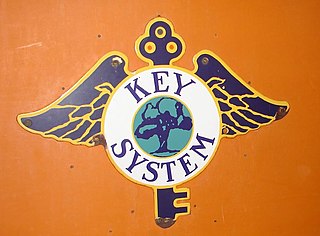
The Key System was a privately owned company that provided mass transit in the cities of Oakland, Berkeley, Alameda, Emeryville, Piedmont, San Leandro, Richmond, Albany, and El Cerrito in the eastern San Francisco Bay Area from 1903 until 1960, when it was sold to a newly formed public agency, AC Transit. The Key System consisted of local streetcar and bus lines in the East Bay, and commuter rail and bus lines connecting the East Bay to San Francisco by a ferry pier on San Francisco Bay, later via the lower deck of the Bay Bridge. At its height during the 1940s, the Key System had over 66 miles (106 km) of track. The local streetcars were discontinued in 1948 and the commuter trains to San Francisco were discontinued in 1958. The Key System's territory is today served by BART and AC Transit bus service.

The Southern California Rapid Transit District was a public transportation agency established in 1964 to serve the Los Angeles metropolitan area. It was the successor to the original Los Angeles Metropolitan Transit Authority (MTA). California State Senator Thomas M. Rees sponsored the bill that created the RTD, which was meant to correct some deficiencies of the LAMTA, and took over all of the bus service operated by MTA on November 5, 1964. RTD was merged into the Los Angeles County Metropolitan Transportation Authority in 1993.
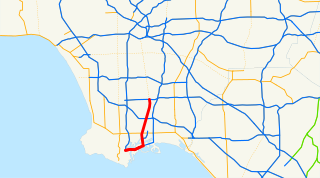
State Route 47 is a state highway in the U.S. state of California, connecting Terminal Island to the mainland in the Los Angeles area. From its south end at I-110 in San Pedro, it heads east across the Vincent Thomas Bridge to the island and the end of state maintenance. The state highway begins again at the junction with I-710 on Terminal Island, crossing the Schuyler Heim Bridge north to the mainland and the second terminus, where SR 103 begins. Signage continues along a locally maintained route, mainly Alameda Street, to the Gardena Freeway in Compton, and an unconstructed alignment follows the same corridor to the Santa Monica Freeway (I-10) near downtown Los Angeles.
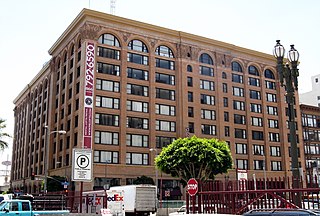
The historic Pacific Electric Building opened in 1905 as the terminal for the Pacific Electric Red Car Lines running east and south of downtown Los Angeles, as well as the company's main headquarters building. It was designed by architect Thornton Fitzhugh. Though not the first modern building in Los Angeles, nor the tallest, its large footprint and ten-floor height made it the largest building in floor area west of Chicago for several decades. Above the main floor terminal were five floors of offices and on the top three floors, the Jonathan Club, one of the city's leading businessmen's clubs. The club moved to its own building on Figueroa Street in 1925. After the absorption of the Pacific Electric into the Southern Pacific Railroad in 1911, the PE Building became the primary Los Angeles offices for the Southern Pacific.
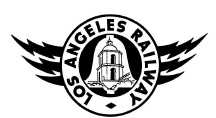
The Los Angeles Railway was a system of streetcars that operated in Central Los Angeles and surrounding neighborhoods between 1901 and 1963. It operated on 3 ft 6 in narrow gauge tracks. The company carried many more passengers than the Pacific Electric Railway's Red Cars, which served a larger area of Los Angeles.
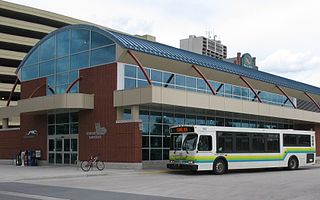
Transit Windsor provides public transportation in the city of Windsor, Ontario, Canada as well as La Salle, Ontario to more than 6 million passengers each year, covering an area of 310 km2 (120 sq mi) and a population of 218,000. They operate a cross border service between the downtown areas of Windsor and Detroit, Michigan via the Tunnel Bus, and service to events at Detroit's Comerica Park, Little Caesars Arena, TCF Center, and Ford Field. The Windsor International Transit Terminal neighbours with the Windsor International Aquatic and Training Centre.

Fair Oaks Avenue in Pasadena, California, is a major north–south road connecting the communities of Altadena, Pasadena, and South Pasadena, running 7.9 miles (12.7 km) in length. It starts at its southernmost end in South Pasadena at Huntington Drive. It travels due north to a terminus above Loma Alta Avenue in Altadena and the gates of Angelus County Park. Beyond this, the road becomes a private easement.
The Long Beach Line was a major interurban railway operated by the Pacific Electric Railway between Los Angeles and Long Beach, California via Florence, Watts, and Compton. Service began in 1902 and lasted until 1961, the last line of the system to be replaced by buses. However, the Southern Pacific Transportation Company continued to operate freight on the tracks, as the Union Pacific Railroad still does north of Dominguez Junction, and in 1990 the Southern California Rapid Transit District opened the Blue Line light rail along the same right-of-way.
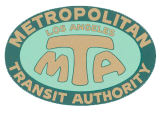
J was a line operated by the Los Angeles Railway from 1911 to 1945, by Los Angeles Transit Lines from 1945 to 1958, and by the Los Angeles Metropolitan Transit Authority from 1958 to 1963

W was a line operated by the Los Angeles Railway from 1895 to 1956.
Streetcars in Los Angeles over history have included horse-drawn streetcars and cable cars, and later extensive electric streetcar networks of the Los Angeles Railway and Pacific Electric Railway and their predecessors. Also included are modern light rail lines.

Los Angeles Pacific Railroad (1899−1906) (LAP) was an electric railway and steam locomotive public transit and cargo shipping railway system in Los Angeles County, California. At its peak it had 180-miles of track from Pasadena, through Downtown Los Angeles, the Westside, and Santa Monica, then to the South Bay towns along Santa Monica Bay.
The Watts line was a local line of the Pacific Electric Railway that operated between the Pacific Electric Building in Downtown Los Angeles, Los Angeles, California, United States and the Watts Station at 103rd Street in Watts, Los Angeles. It was the primary local district service for the Southern District, which also included the Long Beach, San Pedro, Santa Ana and Whittier lines. The route operated along the Southern Division's Four Tracks route, with the Watts Line using the outer tracks and the Long Beach line and other interurban and express lines using the inner tracks. It operated between 1904 and 1958. During the 1910s, its service was combined with the South Pasadena Line of the Northern District. From 1938 to 1950, the line was combined with the Sierra Vista Line, which was the main local line in the Northern District. Since 1990, service along the Watts Line between Washington Boulevard and 103rd Street has been operated by the Los Angeles Metro Blue Line, with stations at Washington Boulevard, Vernon Avenue, Slauson Avenue, Florence Avenue, Firestone Boulevard and 103rd Street.
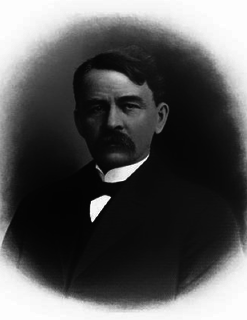
Eli P. Clark (1847-1931) was a pioneer railway builder of Southern California and a leader in the civic, philanthropic and social activities of Los Angeles.














